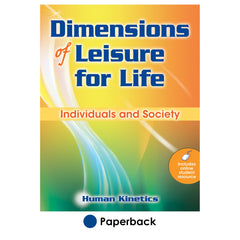Technology can have positive and negative impact on social interactions
This is an excerpt from Dimensions of Leisure for Life by Human Kinetics.

With the proliferation of technologies that are able to overcome the obstacles of time and space (e.g., airplanes, cars, the Internet), one would think that these tools would be used to gain an understanding of other cultures, meet people all over the world, maintain and strengthen familial relationships, communicate effectively with others, and help people to become more socially adept. However, some technological advances cause people to be distracted, overly stressed, and increasingly isolated. Many people are involved in an abundant number of relationships through technology, but sometimes the quantity of these associations leaves people feeling qualitatively empty. Obviously, technology has had a profound impact on what it means to be social.
Society is likely on the cusp of a social revolution, during which it will be important to redefine socially appropriate and acceptable behaviors (with regard to digital or virtual interaction). We are at a point in history where very few people have given critical thought to new social realities created by technology and what those realities mean for the individual and society. In this section we closely examine a few social technologies that influence leisure. The section first looks at virtual communities, social networking sites, and today's communication tools. Then we critically reflect on gaming and television. Think about how each technology affects your social life and social skills. Keep in mind that these are only a few of the technologies that may affect you socially. A comprehensive list is not feasible here.
A study of students and information technology found that 85 percent of undergraduates surveyed used social networking sites (Salaway et al., 2008) (see figure 8.2). Many of the respondents reported using such sites daily. Figure 8.3 indicates how undergraduate students use social networking sites. This report found indications that use of these sites is increasing yearly. Let us now look critically at whether this trend is positive.

The use of social networking sites has both positive and negative consequences. It is amazing how someone can find a long-lost friend through a social networking site, enabling them to reconnect. In a society where people have become quite mobile and family and friends are often geographically separated, it is convenient to keep in touch through technology.
However, one need not look far to find problems associated with social networking sites. There is a lively debate about whether Internet addictions are real. To me it appears to be a real problem (perception is often reality in a social context) with which people have to grapple. Some assert that these Web sites contributed to cheating on significant others, often leading to divorce. People have been fired from their jobs or put under pressure because they use these sites at work or because something is posted on a site that undermined the person's professional standing.
Although divorce and loss of employment are serious issues, perhaps they are not as common as other problems that have the potential to stem from social networking sites. Narcissism—excessive interest in one's appearance and in oneself—is sometimes manifested on social networking sites. These Web sites have been found to be an avenue for people to display their narcissistic traits online (Buffardi & Campbell, 2008). I often wonder whether people use these sites to display their popularity to the world rather than use them as a vehicle to develop meaningful relationships.
Creating meaningful relationships is often about sharing our lives with others, and technology can allow us to do so through photos, videos, text, and music. In conducting research for my doctoral dissertation, I looked at how eight senior citizens used technology and how it affected their lives. My hope was to find that they used technology to stay in touch with friends, family, and people with similar interests. Although the participants did use e-mail to stay in touch with family and friends, almost all of the study participants talked about how vapid chat rooms and discussion boards seemed to be. Most had tried chatting a few times and then gave up because they viewed it as a waste of time (similar reasons were given by undergraduates in the ECAR study who did not use social networking sites). However, one participant was a chat room monitor for a fantasy baseball site. As he spent more time in that chat room he began to realize that it was not as shallow as he first imagined. People were in that virtual community because of a shared or common interest. Gradually he got to know people and care about their lives. He was eventually able to meet some of these new, online friends in person and said they connected as if they had known each other for years.
While working on my dissertation I visited many chat rooms and discussion boards that catered to older adults. After visiting many such sites, I began to be discouraged because of the inane nature of many of the conversations. However, I stumbled on one online discussion board in which two World War II veterans wrote about their experiences in the war. They also lamented the fact that where they lived, there were no more veterans of that war left. They felt alone and isolated, but this chat room was a forum where they fit in again. They were able to share similar interests and experiences.
Perhaps overcoming a sense of isolation is one of the greatest features of online communities and virtual worlds. Someone might feel like an outcast in her own community or family but might find someone online with similar hobbies, pursuits, and interests. Consider someone who enjoys photography as a serious leisure pursuit. This person would be able to share that passion with people all over the world by using the Internet and its powerful tools (e-mail, video chat, discussion boards, online video, family Web sites). However, simply sharing common interests and pursuits with people through technology does not necessarily have a positive impact on social skills and social development.
Gaming and Social Development
Gaming is an instance where you may encounter potentially serious social setbacks. I lead a group of Boy Scouts who share a love of a certain online virtual world game. This game seems to be all they talk about. When given other opportunities for deep, respectful, meaningful conversation, these boys are sometimes rather inept. Although linking their online gaming to poor social skills might be spurious, studies show negative social impacts of some video games. One study tested whether high exposure to video games increased aggression over time. It was found that playing violent video games is a significant risk factor for later physical aggression in both Japan and the United States—for boys and girls (Anderson et al., 2008).
However, linking video games to poor social skills and behaviors often misses the bigger picture. People might participate in other activities (take football, for example) in which the social problems that arise from the activity may be the same or even worse than those of gaming. Evidently it is not enough to simply blame the medium. In fact, in many instances, gaming may aid in relationship building. The 13th Annual MediaWise Video Game Report Card (Walsh & Gentile, 2008) indicated that 75 percent of gamers play with other people. Since my family received a Wii as a gift, we have spent countless hours of enjoyment playing together. Naturally, overindulgence in this one activity would have deleterious results, but the limited time we do spend playing together seems to strengthen our family.
Television and Social Development
Television is another technology that has mixed reviews with regard to social skills and social lives. Some researchers suggest that spending a limited amount of time watching wholesome programs can strengthen families and friendships. Others believe that television contributes to the downfall of social values in this country. It does seem that many people spend less time with others in their community than they do with the people they watch daily on television. Television tends to be a passive medium, which requires little skill and thought on our part (although some programming bucks this trend). Therefore, television provides little opportunity for meaningful interaction while watching. Watchers simply sit there and ingest what is presented to them without having to respond or react to another person. Obviously this can have serious effects on people's social skills because viewers are not practicing how to relate to and deal with other people.
Exposure to what is viewed on television can have some other serious effects on people's social lives. For example, exposure to television shows with sexual content may increase the chance of teen pregnancy (see figure 8.4) (Chandra et al., 2008). Furthermore, when some people see violence, sex, and all manner of lasciviousness on television, they may be prone to mimic the behavior and think that it is acceptable. Were everyone to copy the social behaviors portrayed on television, our society would lack morals, and many levels of individuals' lives would be destroyed.

It is apparent that technology has the potential to harm or enhance your social skills and social life. The key is to analyze how technology affects you socially. Do technologies help you build positive, meaningful relationships, or do technologies hinder this process? Are you better able to communicate, listen, and share because of the technologies in your life? Do you use technologies to improve your relationships and build new ones? Are you letting a few choice people know who you are and what you contribute to this world, or are you merely distracting yourself with shallow pursuits? Does technology increase or decrease your concern for others, your compassion for others, and your desire to serve them? Such are the critical questions regarding technology and social development.
Learn more about Dimensions of Leisure for Life.
More Excerpts From Dimensions of Leisure for Life

Get the latest insights with regular newsletters, plus periodic product information and special insider offers.
JOIN NOW


